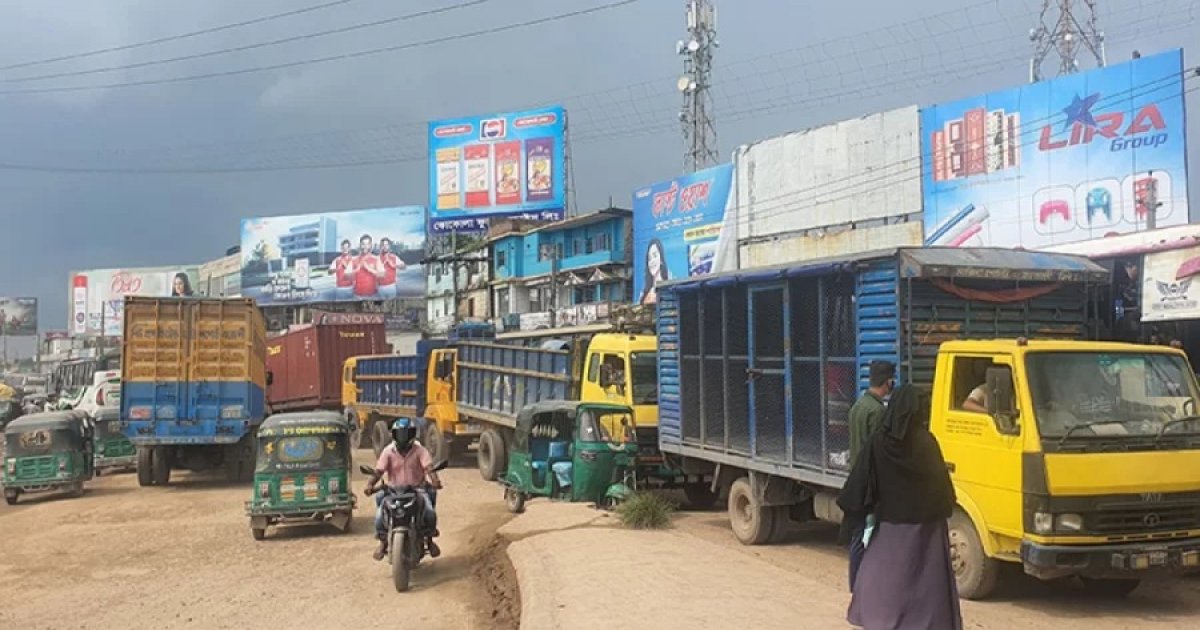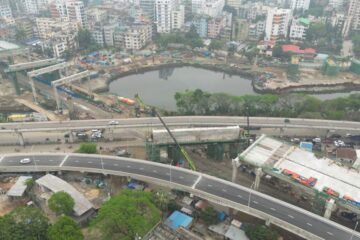It is crucial for the government to grasp this sooner rather than later to maintain national unity and solidarity, and to prevent the emergence of a narrative of regional neglect. If past experiences in our modern statehood are any guide, we should know better than anyone that public fury over regional deprivation is always a recipe for disaster.
For too long, travelers on the Dhaka-Sylhet route — Bangladesh’s National Highway 2 (N2) — have endured immense suffering due to its terribly-dilapidated condition, making the journey excruciatingly painful. The N2’s development and expansion work has taken an unbelievably long time, almost worthy of a record for project delays. What should ideally be a five-hour drive now takes anywhere between 12 and 25 hours.
Those traveling to the greater Sylhet region from Dhaka or other parts of the country for business, work, or study often complain about the lack of alternatives. The frequency and number of trains to and from Sylhet are inadequate, and passengers continue to suffer from black-market ticketing with little remedy. Even in the digital ticketing era, too many tickets end up in the hands of touts and racketeers, forcing passengers to buy them at inflated prices.
A handful of airlines operating between Dhaka and Sylhet appear to take full advantage of passengers’ helplessness. A one-way fare that normally ranges between Tk 3,000 and Tk 3,500 is being artificially inflated to Tk 10,000 or more — beyond the reach of most travelers.
A region with so much to offer
The four northeastern districts — Sylhet, Sunamganj, Moulvibazar, and Habiganj — are home to over 12 million people in a country of 170 million. In other words, at least seven out of every 100 Bangladeshis call Sylhet Division home. The region is rich in heritage, natural beauty, and resources; it is the heartland of Bangladesh’s tea production and one of the top contributors to the nation’s remittance inflow. Sylhet ranks third among the top five districts that receive 60% of remittances from migrant workers. It was also the only region in then-East Bengal where people voted in a plebiscite to choose between India and Pakistan in 1947.
It is not only about the people native to the region, but also about the thousands who have migrated there from central and other parts of Bangladesh in search of better opportunities. These newcomers now constitute a sizeable part of the community, contributing to both the regional and national economy. New industries, resorts, and tourism facilities have sprung up in Habiganj and other areas, creating much-needed jobs for unemployed youth.
However, with the route’s communication network now in a dire state, industries are failing to meet shipment deadlines, hotels and resorts are losing visitors, and people are suffering immensely. Many have to cancel or reschedule their trips, while others are forced to pay higher fares and spend countless extra hours on the road.
In recent weeks, the people of the northeast held rallies, organized human chains and seminars, and employed every peaceful means — in Dhaka, in Sylhet, and through the diaspora community — to make their voices heard.
So far, little has come of it — except for the spectacle of an adviser’s motorcycle ride on the Dhaka-Sylhet highway.
The transitional government’s adviser in charge of roads and highways recently visited the Brahmanbaria section of the highway to witness firsthand why vehicles take 10, 15, or even 20 hours to travel between Sylhet and Dhaka. Stuck in potholes, the adviser and his entourage were forced to disembark from their vehicles, and he proceeded on a motorcycle as a pillion rider to inspect the road condition.
What the adviser saw was only a glimpse of the daily ordeal thousands endure on this route. His gesture was praiseworthy, as he demonstrated a sense of urgency and directed officials to expedite supervision and monitoring of the project. Yet, the problem with the N2 runs far deeper.
Back in 2018, when a Chinese company was about to be awarded the 226-km Dhaka-Sylhet six-lane project (comprising a four-lane main carriageway and service lanes on both sides), the then finance minister suddenly claimed that the company had attempted to bribe a senior government bureaucrat.
That controversy led to further delays. Many developments followed, and after last year’s July Revolution — which saw Hasina flee the country — Indian contractors and workers operating on the Ashuganj-Brahmanbaria section also left Bangladesh.
Although work has resumed after many months, it is learned that only about 20% of the 226-km stretch has been completed so far. For anyone traveling the route, this rate of progress is nightmarish — how many more months, or rather years, must people wait to access a functional highway to the northeast?
To give an example of slow progress in any project’s work, we commonly speak of snail’s pace. At its average pace (0.048 kilometers per hour), even a snail could travel from Dhaka to Sylhet in six months. Since the government formally launched the highway expansion work in October 2021, a snail could have traversed the distance nearly eight times by now.
According to media reports, four years after the six-lane project began, authorities have still not completed the necessary land acquisition for widening the highway. This delay has caused massive cost escalations. Contractors cannot begin full-scale work while the land acquisition process drags on — especially in Sylhet and Habiganj, where progress has been minimal. The delay has also prevented utility services from being relocated in key areas, further threatening the project timeline.
The Dhaka–Sylhet highway construction is jointly financed by Bangladesh and the Asian Development Bank (ADB). The N2 serves as a crucial artery for national connectivity and regional trade. Unfortunately, the originally anticipated completion date of 2026 now appears increasingly unrealistic.
A key takeaway for the government from this painfully slow project should be this: Never initiate land acquisition and infrastructure construction simultaneously in major civil projects. The two tasks must be approached independently. A separate project should handle land acquisition in advance. Without timely land acquisition, construction delays inevitably cause cost overruns and immense suffering for road users. Completing land acquisition first would expedite such projects significantly.
In recent years, people in the northeast have also suffered from unplanned and reckless infrastructure projects in the haor region, which obstructed natural water flow. Thousands were marooned in devastating floods that many blamed on the so-called all-weather road constructions across the wetlands.
The people of the northeast deserve urgent and sincere attention from the government to assure them that their region’s concerns are neither neglected nor forgotten. The least the government could do now is expedite the six-lane highway work, ease travelers’ suffering, introduce more trains on the Dhaka-Sylhet and Chittagong-Sylhet routes, and bring discipline to airfares on the Dhaka-Sylhet sector.
Above all, why must the national carrier, Biman Bangladesh Airlines, be allowed to charge arbitrarily high fares on this route?
Reaz Ahmad is Editor, Dhaka Tribune.



